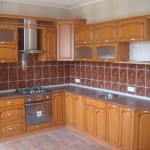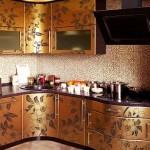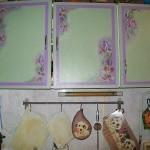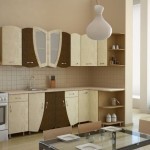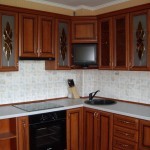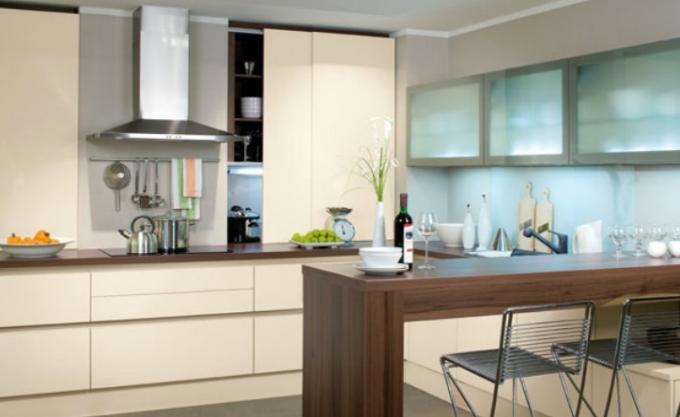Content
- 1 Methods of restoration of kitchen facades
-
2 We will restore the facades ourselves
- 2.1 Painting facades in the kitchen
- 2.2 Pasting of facades with self-adhesive foil
- 2.3 Varnishing of wooden facades
- 2.4 Panel replacement
No matter how high-quality the kitchen facade is, sooner or later it loses its attractiveness. And in this situation, either a complete replacement of damaged and worn-out elements, or the restoration of kitchen facades with your own hands, will help.
We will talk about the methods of such restoration in this article.

Facade elements during restoration
Methods of restoration of kitchen facades
During operation, kitchen fronts - regardless of what material they are made of - lose their presentable appearance.
Mechanical damage, stubborn stains appear on them, and an element of the fittings becomes unusable. In general, the kitchen façade is no longer perfect and requires restoration.
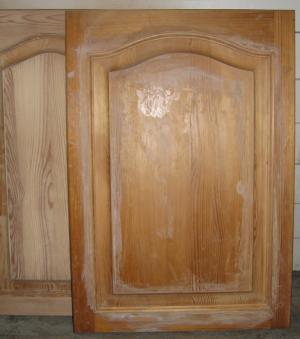
Kitchen facade in need of restoration
Note!
According to statistics, facades with a plastic coating, as well as glass facades made of tempered glass, are the longest accompanied by aging and wear.
But on the other hand, the restoration of such facades is the most difficult and expensive.
To return the kitchen to its original beauty, you can replace the facades with new ones. True, the price of such facades will be quite high.
If you do not want to spend such a significant amount on the restoration of the kitchen, then you can try to restore the facades yourself. At the same time, the restoration will not only restore the attractive appearance of the kitchen, but also provide an opportunity to introduce new design solutions into it.
The most relevant today are the following ways to update facades:
- Painting of facades with interior paints.
- Pasting of kitchen furniture with self-adhesive polymer films.
- Varnishing wooden facades for the kitchen.
- Replacement of panels with rattan, glass and other materials.
It is about these methods of restoration that we will talk in detail about.
We will restore the facades ourselves
Painting facades in the kitchen
Painting the facades is a rather radical restoration method, but it should only be used when the façade base is in good condition. If the facade has mechanical damage - peeling of the laminating film, swelling of the veneer, cracks - then it must be put in order before painting.

Degreasing facades
Instructions for painting facades are as follows:
- We remove the facades from the kitchen furniture, putting markings on their inner side so that we know where the door is from.
Note!
It is better to do all restoration work on the facades removed from the hinges - therefore, in further descriptions we will omit this point.
- We remove the handles and hinges from the doors. We thoroughly wash all surfaces of the facades, after which we degrease them with "White Spirit".
- We clean all surfaces with fine grain sandpaper, remove dust and degrease again.
- After degreasing, we proceed directly to painting. initially paint over hard-to-reach places of the kitchen facade - panels, recesses, carvings, etc. After that, we paint smooth surfaces.
- If necessary, repeat the painting until we achieve the desired result.
- After the paint has dried, we fasten the fittings and return the facades to their place.

Painting the kitchen facade
Advice!
When painting, you can apply ornaments to the facade using a stencil.
Pasting of facades with self-adhesive foil
Vinyl self-adhesive film, which is abundantly presented on the shelves of hardware stores, is a very promising material for restoring kitchen facades.
The pattern and texture of such a film can be very different - from the traditional imitation of natural wood to embossed leather or natural stone (pictured).

Original textures of vinyl film
Note!
The restoration of kitchen facades requires the use of high-quality films, so you should not save money by purchasing too cheap options.
An inexpensive film will not last on furniture for several months, and the restoration will have to be repeated.
Pasting is done like this:
- The removed facade with the dismantled hinges and handles is washed with warm water and laundry soap and degreased.
- We cut the film along the centimeter grid from the seamy side.
- Starting from one of the edges of the facade, we roll out the film, gradually removing the protective layer.
- We level the film with a spatula or by hand, accelerating from the center to the edges.
- If air bubbles have formed (which is undesirable), pierce them with a needle or cut them.
- If the film is uneven, we immediately remove it and replace it with another fragment. In no case should you re-stick the film - it will still not stick.
Varnishing of wooden facades
Solid wood kitchen fronts natural wood also lends itself well to restoration, while, unlike all other facades, they can almost completely preserve their original appearance. The wooden facade can be reopened with varnish - and it will look new!
Advice!
To master the technique of varnishing furniture - carefully study the video instructions.
Restoring wooden doors from a kitchen unit is done as follows:
-

Opening the facade with varnish
We carefully grind the door removed from the hinges, first with medium-grained, and then with fine-grained sandpaper.
- If the reason for the restoration was the crumpling of the door and the formation of cracks on it, we fill them with putty, after which we grind the facade clean.
- We degrease the facade and apply a primer to it.
- After the primer has dried, we begin varnishing the facade. Add a tint component to the deepest layers of varnish, gradually reducing its amount.
- Make the last layer of varnish transparent.
After drying, we mount the fittings on the facade and return it to its place.
Panel replacement
Another way to restore facades is to replace panels in facades with natural wood trim.
For this:
- We carefully dismantle the trim of the facade, trying not to damage the front groan of the slats.
- We take out the old panel from the groove.
- We grind and varnish the strapping elements - we described how to do this in the previous section.
- In place of the panel, we insert a fragment of decorative glass, rattan cloth, etc., suitable in size. Here, only fantasy limits us in the choice of material.
- We fix the new filling and glue the strapping again.

Refurbished rattan facades
As you can see, the restoration of kitchen furniture facades is not a big deal. Of course, in a number of situations you will either have to contact the masters or change the facades completely - but if the damage is insignificant, then you can quickly provide the kitchen with a "new life".
Gallery








